The Sword in the Stone (1963)
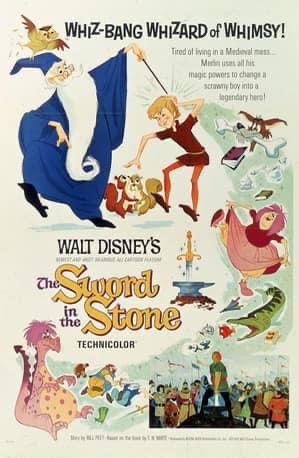
The Sword in the Stone (1963) is a delightful animated adaptation of the King Arthur legend, crafted with a playful and lighthearted touch by Walt Disney Productions. Directed by Wolfgang Reitherman, the film is based on T.H. White’s novel and captures the early adventures of Arthur, known here as “Wart,” a humble orphan who, through a series of magical encounters and lessons, is destined to become one of the greatest rulers in English legend.
Suggested videos for
Plot Overview
The film follows young Wart, who lives in medieval England under the care of Sir Ector, a gruff knight, and dreams of becoming a squire. Wart’s life changes when he encounters Merlin, a quirky and wise old wizard with a penchant for unconventional teaching methods. Merlin takes it upon himself to mentor Wart, guiding him with lessons that emphasize the importance of knowledge, understanding, and self-reliance over physical might. Wart is transformed into various animals—a fish, a squirrel, and a bird—each experience offering unique insights into survival, courage, and perspective.
As Merlin teaches Wart about the world and the value of intellect, the two characters also encounter whimsical figures like Merlin’s pet owl, Archimedes, who is often grumpy but knowledgeable, and Madam Mim, a mischievous witch and Merlin’s playful rival. In the film’s climax, Wart stumbles upon a legendary sword lodged in a stone. When he pulls the sword free with ease, he is revealed as the true king, destined to lead with wisdom and compassion.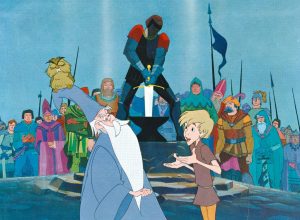
Characters and Performances
The characters in The Sword in the Stone bring much of the film’s charm. Wart, voiced by three different actors, represents youthful innocence and curiosity, though the occasional vocal inconsistency is a minor distraction. Merlin, voiced by Karl Swenson, is a standout as the eccentric mentor. His quirky personality, witty dialogue, and occasional exasperation bring humor to the character, who is both wise and absent-minded. Archimedes, Merlin’s cantankerous owl companion, provides sharp wit and humor, contrasting with Merlin’s sometimes chaotic energy.
Madam Mim, voiced by Martha Wentworth, steals the show during her brief appearance. She’s memorable as a comical, slightly sinister character who revels in mischief and chaos. Her magical duel with Merlin is one of the most visually engaging and humorous scenes, highlighting both her villainous charm and Merlin’s clever resourcefulness.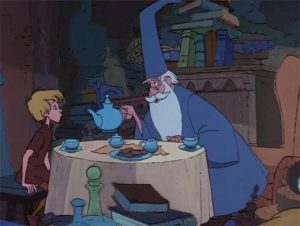
Themes and Messages
The Sword in the Stone conveys themes of knowledge, courage, and the value of intelligence over brute strength. Merlin’s lessons emphasize that true strength comes from within, encouraging Wart to think critically, adapt, and remain humble. Through these magical experiences, Wart learns to see life from different perspectives, gaining empathy and resilience that ultimately prepare him for leadership.
The film also explores the idea of destiny versus choice. While Merlin hints that Wart is destined for greatness, he focuses on preparing him for whatever lies ahead, emphasizing the importance of personal growth over fate. This gentle, philosophical approach sets the film apart, making it less about grandiose heroism and more about a young boy’s quiet journey toward self-discovery.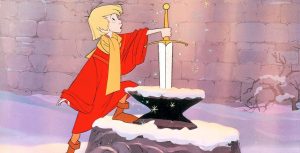
Animation and Art Style
The animation in The Sword in the Stone has a distinctive, sketchy quality, characteristic of Disney’s early use of the xerography process, which transferred the animators’ pencil lines directly to the screen. This method gives the film a textured, almost hand-drawn look, which, while less polished than Disney’s earlier works, complements the earthy, medieval setting. The backgrounds are richly detailed, evoking the English countryside, castles, and forests with a muted yet warm color palette.
One of the animation highlights is the transformation sequences, where Wart becomes different animals and learns valuable life lessons. Each transformation brings vibrant visual storytelling as Wart experiences the world through new perspectives. The duel between Merlin and Madam Mim is also a visual treat, showcasing creative, fluid animation as the two wizards transform into various creatures in a magical battle of wits.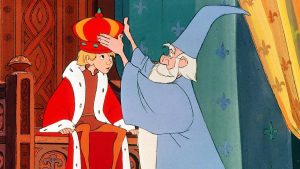
Music and Soundtrack
The film’s music, composed by the Sherman Brothers (known for Mary Poppins and The Jungle Book), features lighthearted songs like “Higitus Figitus” and “That’s What Makes the World Go Round.” These songs are playful and fun, matching Merlin’s whimsical personality and Wart’s coming-of-age journey. While not as iconic as some of Disney’s other soundtracks, the music in The Sword in the Stone enhances its charm and supports the film’s upbeat, carefree tone.
Criticisms
The Sword in the Stone is often criticized for its episodic structure, which can make the story feel a bit disjointed. Each of Merlin’s lessons feels like its own mini-adventure, with the main plot of Wart’s journey to the throne only coming into focus near the end. This structure may leave some viewers wishing for a more cohesive narrative and deeper character development.
Additionally, while Wart is an endearing protagonist, he sometimes lacks depth, primarily serving as a vessel for Merlin’s teachings rather than as an active character. The film’s pacing is leisurely, which can feel slow compared to the high-stakes storytelling of other Disney films.
Legacy and Conclusion
Despite its shortcomings, The Sword in the Stone remains a beloved film for its whimsical tone, clever humor, and unique take on the Arthurian legend. Its focus on teaching values like curiosity, intelligence, and adaptability rather than simply emphasizing heroism gives it a timeless appeal, particularly for younger audiences. The characters of Merlin and Archimedes, with their humorous interactions and engaging personalities, provide much of the film’s memorable charm, while the animation and music capture the early-1960s Disney aesthetic.
Though it may not reach the iconic status of other Disney classics, The Sword in the Stone endures as a fun, magical adventure with a meaningful message. Its emphasis on wisdom, self-discovery, and kindness makes it a valuable addition to Disney’s animated canon and a cherished story that continues to resonate with audiences of all ages.











